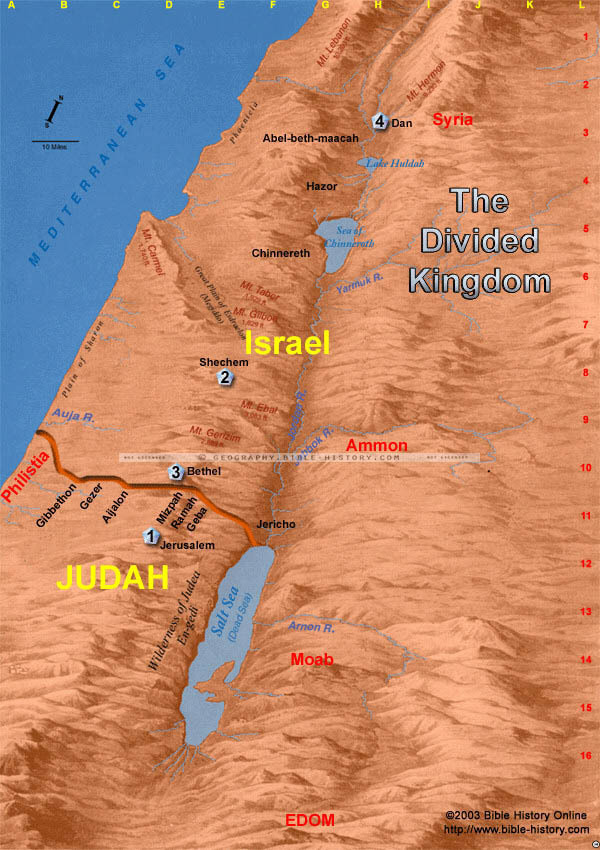
The map of the Divided Kingdom offers a compelling visual representation of a pivotal period in the history of ancient Israel. Following the reign of King Solomon, the kingdom split into the northern Kingdom of Israel and the southern Kingdom of Judah, each with its own distinct history and challenges.
Geographical Split:
This map vividly illustrates the geographical division that occurred after Solomon's reign, with the northern Kingdom of Israel comprising the territory north of Jerusalem and the southern Kingdom of Judah centered around Jerusalem and the surrounding regions.
Kingdoms and Capitals:
It highlights the capitals and major cities of both kingdoms, including Samaria in the north for Israel and Jerusalem in the south for Judah. These cities served as political and religious centers.
Tribal Territories:
The map outlines the tribal territories within each kingdom, reflecting the division of the twelve tribes of Israel, with ten tribes in the north and two in the south.
Prophets and Religious Centers:
It marks significant religious centers and the locations where prophets such as Elijah, Elisha, and Isaiah delivered their messages. These sites played a crucial role in the religious life of the divided kingdoms.
Historical Events:
The map may incorporate key historical events and battles that took place during this period, including conflicts with neighboring nations and the eventual conquests by Assyria and Babylon.
Cultural and Religious Dynamics:
Exploring the map allows viewers to gain insights into the cultural and religious dynamics of the northern and southern kingdoms, including the worship of different gods and the influence of foreign cultures.
Prophetic Warnings and Exile:
The map may indicate locations associated with prophetic warnings of impending doom and the subsequent exile of the northern tribes by the Assyrians and the southern kingdom's exile by the Babylonians.
Continuity and Legacy:
This map may also include markers or references to the survival of certain traditions, tribes, and religious practices in the post-exilic period and the eventual return to the land.
The map of the Divided Kingdom offers viewers a rich and educational journey through a critical period in the history of ancient Israel. It allows them to explore the geography, tribal divisions, historical events, and religious dynamics that shaped the destinies of the Kingdom of Israel and the Kingdom of Judah, deepening their understanding of the biblical narrative and its enduring legacy.
Blank Topo Map of The World
Abraham’s Journey
The Captivity of Judah (586-516 B.C.)
The Fall of Judah 586 B.C.
The Northern Kingdom of Israel
The Southern Kingdom of Judah
The Divided Kingdom
The Fertile Crescent
Ur of the Chaldees
Shechem in Old Testament Times
Prophets, Kings, and Nations
Jesus Last Passover
New Testament Israel
New Testament Places
Old Testament Israel
Provinces of the Roman Empire
Israel during David’s Kingdom
David’s Kingdom
Cities of the New Testament 4
Cities of the New Testament 3
Cities of the New Testament 2
Mediterranean Sea
Cities of the New Testament
First Century Jerusalem
Empire of David and Solomon
David’s Kingdom
Israel Under Rehoboam
Ophir and Tarshish
The Period of the Kings
Ramoth Gilead
Samaria
Solomon’s Temple
Zarephath and MT Carmel
Jabesh Gilead and Tribes
Judah in the Time of David
Kingdom of Saul
Kirjath Jearim
Michmash
Mount Gilboa in the Time of David
Nob Davids Flight
Shiloh
Israel and Judah
Assyrian Empire Under Esarhaddon
Assyrian Empire Under Sennacherib
Captivity of 10 Tribes
Events in 2 Kings
The Khabur River
Israel and Syria
Captives From Judah
Kingdom of Jeroboam
Mesha’s Kingdom
Pharaoh Necho Battles King Josiah at Megiddo
Babylonian, Mede and Persian Empires
Samaria and Nearby Territories
Syria at its Height
Hebron
Mahanaim
1949 Map of Israel With Boundaries
First & Second Journeys of Paul
Journeys of the Apostles
Paul’s Third Missionary Journey
Saul’s Journey to Damascus and Arabia
Paul’s Final Visits
Paul’s 1st Missionary Journey
Paul’s 2nd Missionary Journey
Paul’s 3rd Missionary Journey
Paul’s Voyage to Rome
Phillip Journeys to Samaria and Gaza
Judah at the Time of Amos
Empire of Alexander the Great
Israel Under the Maccabees
Galilee During Maccabees
Idumea Intertestamental Period
Kingdom of the Ptolemies
Kingdom of the Seleucids
Ptolemaic Egypt Seleucid Asia
The Roman World
Kingdom of Ptolemies and Seleucids
The World During the 6TH Century BC
Mount Horeb
The Red Sea
The Exodus
Ezra’s Journey to Restore Jerusalem
Israel and Judah During Hosea’s Time
The Ancient World
Canaan During the Time of Abraham
The City of Shechem
Supposed Location of the Garden of Eden
The Land of Israel in Genesis
The Jordan River
The Kingdom of Nimrod
Mount Ararat and Mesopotamia
The Descendants
Sodom and Gomorrah
The Kingdom of Egypt
The Hamites
The Kingdom of the Hittites
Ur of the Chaldees
Judah at the Time of Haggai
Jesus Passes Through Samaria
